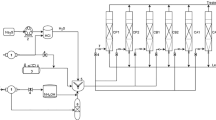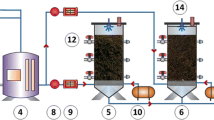Abstract
The performance of a laboratory-scale biofilter packed with a mixture of compost and woodchip on formaldehyde removal from polluted air streams was investigated. The reactor was inoculated with aerobic sludge as a source of bacteria, obtained from a municipal wastewater treatment plant. A nutrient solution was daily added to the reactor media. An airflow containing different concentrations of formaldehyde (from 20 ± 2 to 276 ± 5 mg m−3) was introduced into the reactor. In inlet formaldehyde concentration, an average removal efficiency and elimination capacity of 91 % and 0.36 g m−3 h−1 were attained, respectively, at180 s empty bed residence time (EBRT). After acclimatization of the system for increased formaldehyde concentrations of up to 276 ± 5 mg m−3 and for EBRT of 180 s, those values were stabilized at around 72 % and 3.98g−3 h−1, respectively. The experimental results showed that the system was effective for a high loading rate of formaldehyde with an acceptable EBRT. Compared to the application of compost alone as a media, a mixture of compost and woodchip (50/50 v/v%) enhanced the performance of the biofilter. The most predominant microorganism involved in the biodegradation of formaldehyde was a species of citrobacter called Citrobacter freundii, an aerobic gram-negative bacillus. Pressure drop of the reactor over the entire operations was about 1 mmH2O m−1.





Similar content being viewed by others
References
Akbar-Khanzadeh, F., & Park, C. K. (1997). Field precision of formaldehyde sampling and analysis using NIOSH method 3500. American Industrial Hygiene Association Journal, 58(9), 657–660.
Andersson Chan, A., (2006). Biofiltration of odorous gas emissions.
Arulneyam, D., & Swaminathan, T. (2003). Biodegradation of methanol vapor in a biofilter. Journal of Environmental Sciences, 15(5), 691–696.
Balasubramanian, P., Philip, L., & Murty Bhallamudi, S. (2012). Biotrickling filtration of VOC emissions from pharmaceutical industries. Chemical Engineering Journal, 209, 102–112.
Cai, Z., & Sorial, G. A. (2009). Treatment of dynamic VOC mixture in a trickling-bed air biofilter integrated with cyclic adsorption/desorption beds. Chemical Engineering Journal, 151(1–3), 105–112.
Cho, K.-S., Hirai, M., & Shoda, M. (1992). Enhanced removal efficiency of malodorous gases in a pilot-scale peat biofilter inoculated with Thiobacillus thioparus DW44. Journal of Fermentation and Bioengineering, 73(1), 46–50.
Chung, Y.-C. (2007). Evaluation of gas removal and bacterial community diversity in a biofilter developed to treat composting exhaust gases. Journal of Hazardous Materials, 144(1), 377–385.
Cox, H. H. J., & Deshusses, M. A. (2000). Innovative experimental setup for the parallel operation of multiple bench scale biotrickling filters for waste air treatment. Environmental Technology, 21(4), 427–435.
Delhoménie, M. C., & Heitz, M. (2005). Biofiltration of air: a review. Critical Reviews in Biotechnology, 25(1–2), 53–72.
Diks, R., Ottengraf, S., & Van den Oever, A. (1994). The influence of NaCl on the degradation rate of dichloromethane by Hyphomicrobium sp. Biodegradation, 5(2), 129–141.
Eller, P. M., & Cassinelli, M. E. (1994). NIOSH manual of analytical methods (4th ed.). Ohio: DIANE Publishing.
Ezeonu, C.S., et al. (2012). Biotechnological tools for environmental sustainability: prospects and challenges for environments in Nigeria—a standard review. Biotechnology Research International, 2012.
Fagnani, E., et al. (2003). Chromotropic acid–formaldehyde reaction in strongly acidic media. The role of dissolved oxygen and replacement of concentrated sulphuric acid. Talanta, 60(1), 171–176.
Gregersen, T. (1978). Rapid method for distinction of gram-negative from gram-positive bacteria. European Journal of Applied Microbiology and Biotechnology, 5(2), 123–127.
Iranpour, R., et al. (2005). Literature review of air pollution control biofilters and biotrickling filters for odor and volatile organic compound removal. Environmental Progress, 24(3), 254–267.
Kansal, A. (2009). Sources and reactivity of NMHCs and VOCs in the atmosphere: a review. Journal of Hazardous Materials, 166(1), 17–26.
Leson, G., & Winer, A. M. (1991). Biofiltration: an innovative air pollution control technology for VOC emissions. Journal of the Air & Waste Management Association, 41(8), 1045–1054.
Marek, J. (1999). Gel entrapped cells for waste gas biofiltration. Belgium: Mededelingen-Faculteit Landbouwkundige en Toegepaste Biologische Wetenschappen Universiteit Gent.
Matteau, Y., & Ramsay, B. (1999). Thermophilic toluene biofiltration. Journal of the Air & Waste Management Association, 49(3), 350–354.
Mudliar, S., et al. (2010). Bioreactors for treatment of VOCs and odours—a review. Journal of Environmental Management, 91(5), 1039–1054.
Oliveira, S. V. W. B., et al. (2004). Formaldehyde degradation in an anaerobic packed-bed bioreactor. Water Research, 38(7), 1685–1694.
Oude Luttighuis, H. Improvement of biofilter-technology by a new type of packing material. In Proceedings of the 91st Annual Meeting & Exhibition of the Air & Waste Management Association. 1998. Air & Waste Management Association Pittsburgh.
Pagans, E1., Font, X., & Sánchez, A. (2005). Biofiltration for ammonia removal from composting exhaust gases. Chemical Engineering Journal, 113(2), 105–110.
Park, D.-W., et al. (2002). Biodegradation of toluene by a lab-scale biofilter inoculated with Pseudomonas putida DK-1. Environmental Technology, 23(3), 309–318.
Powers, E. M., & Latt, T. G. (1977). Simplified 48-hour IMVic test: an agar plate method. Applied and Environmental Microbiology, 34(3), 274–279.
Prado, O. J., Veiga, M. C., & Kennes, C. (2004). Biofiltration of waste gases containing a mixture of formaldehyde and methanol. Applied Microbiology and Biotechnology, 65(2), 235–242.
Prado, O. J., Veiga, M. C., & Kennes, C. (2006). Effect of key parameters on the removal of formaldehyde and methanol in gas-phase biotrickling filters. Journal of Hazardous Materials, 138(3), 543–548.
Prado, O., Veiga, M., & Kennes, C. (2008). Removal of formaldehyde, methanol, dimethylether and carbon monoxide from waste gases of synthetic resin-producing industries. Chemosphere, 70(8), 1357–1365.
Qi, B., Moe, W., & Kinney, K. (2002). Biodegradation of volatile organic compounds by five fungal species. Applied Microbiology and Biotechnology, 58(5), 684–689.
Rene, E. R., Veiga, M. C., & Kennes, C. (2009). Performance of a biofilter for the removal of high concentrations of styrene under steady and non-steady state conditions. Journal of Hazardous Materials, 168(1), 282–290.
Seignez, C., et al. (2001). A procedure for production of adapted bacteria to degrade chlorinated aromatics. Journal of Hazardous Materials, 84(2), 265–277.
Sene, L., et al. (2002). Sugarcane bagasse as alternative packing material for biofiltration of benzene polluted gaseous streams: a preliminary study. Bioresource Technology, 83(2), 153–157.
Soccol, C. R., et al. (2003). Biofiltration: an emerging technology. Indian Journal of Biotechnology, 2(3), 396–410.
Sorial, G. A., et al. (1995). Evaluation of trickle-bed biofilter media for toluene removal. Journal of the Air & Waste Management Association, 45(10), 801–810.
Talapatra, A., & Srivastava, A. (2011). Ambient air non-methane volatile organic compound (NMVOC) study initiatives in India—a review. Journal of Environmental Protection, 2(1), 21–36.
Vergara-Fernández, A., et al. (2007). Effects of gas flow rate, inlet concentration and temperature on the biofiltration of toluene vapors. Journal of Environmental Management, 84(2), 115–122.
Xu, Z., et al. (2010). Formaldehyde biofiltration as affected by spider plant. Bioresource Technology, 101(18), 6930–6934.
Yoshida, K., et al. (2009). Bioremediation potential of formaldehyde by the marine microalga nannochloropsis oculata ST-3 strain. Applied Biochemistry and Biotechnology, 157(2), 321–328.
Acknowledgments
The authors would like to gratefully acknowledge the research deputy of Isfahan University of Medical Sciences (IUMS) for support for this work via grant no. 391241.
Author information
Authors and Affiliations
Corresponding author
Rights and permissions
About this article
Cite this article
Rezaei, M., Fazlzadehdavil, M. & Hajizadeh, Y. Formaldehyde Removal from Airstreams Using a Biofilter with a Mixture of Compost and Woodchips Medium. Water Air Soil Pollut 226, 2242 (2015). https://doi.org/10.1007/s11270-014-2242-0
Received:
Accepted:
Published:
DOI: https://doi.org/10.1007/s11270-014-2242-0




